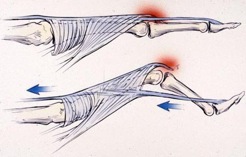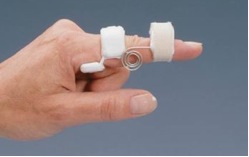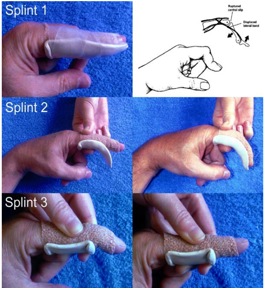Boutonniere Deformity
Boutonniere is a characteristic deformity of the finger, in which the finger's middle joint (called the PIP joint) bends downwards, and the joint at the end of the finger (called the DIP joint) extends upwards. Boutonniere is French for button and the deformity is so called because the finger looks like it is pushing on a button.
Why have I got Boutonniere deformity?
It is often caused as a result of damage to the finger's extensor tendon (called the central slip). The central slip runs along the back of the finger and attaches to the middle bone of the finger and its role is to straighten the joint. This tendon can snap when an straight finger is forcefully bent or as a result of a dislocation of the joint. A cut on the back of the finger near the joint can also sever the central slip. Boutonniere deformity can also occur in patients with rheumatoid arthritis, which sometimes causes the tissues that stabilise the tendons on the back of the finger to weaken and split.

If a central slip injury is not treated quickly and properly
the tissue stabilising the other extensor tendons (known
as the lateral bands) will gradually weaken, resulting in
an imbalance in the forces that control the joints of the
finger-causing the finger to bend into a Boutonniere deformity.
When the deformity has just occurred the PIP joint cannot be straightened on its own, but can be straightened using the other hand. In a long standing central slip injury the joint may become stiff and fixed in the bent position,
and unable to be straightened.
What are the none operative treatment options ?
These include custom made splints and hand therapy to help improve function. If the injury to the central slip is not detected early the joint will stiffen quickly. Corrective surgery will not be possible until full range of motion is achieved and the stiffness has been worked loose. Splints will be required to help with this.

What are the operative treatment options?
For cuts and traumatic joint dislocations, surgery is often required to repair the central slip. This is done through a 4-5cm incision over the back of the finger. The injured tendon is identified and repaired with a suture, the repair is held with splints which stops the finger from bending too much.
In rheumatoid patients the central tendon tissue is weak and repair is not possible. Tendon transfers are the treatment of choice in rheumatoid arthritis and help to regain useful function. However when the deformity is longstanding and the joint is stiff; fusion will give the best results. Fusion of the joint will leave the finger unable to bend but is pain free and will be set in a good position to allow pinching and gripping.

What can I expect after surgery?
Repair of central slip and Tendon transfer
Splint 1 - This should be worn all the time and only be taken off for exercises in the other splints (2 and 3).
Splint 2 - This splint is designed to allow increasing flexion of the finger joint without letting it bend too much which would pull apart the repaired tendon. As shown in the picture; the nearest end of the splint must be held onto the finger with the other hand. The injured finger is then gently flexed until it is stopped by the splint. The therapist will gradually increase the amount of bend in the splint. The finger is then straightened and this is repeated 6 times before and after every meal (6 times a day).
Splint 3 - This splint allows the end joint of the finger to bend but not the injured joint. The exercises stop the end joint getting stiff and should be repeated 6 times after splint 2 exercises.
Fusion of PIPJ
If the joint and surrounding soft tissues are badly worn the finger is better treated with a fusion. This is is achieved by putting the finger joint in the most useful position and fixing it there permenantly. Although there is no movement in that particular joint; all the others continue to move, it is not painful and you will have better use of the finger.



